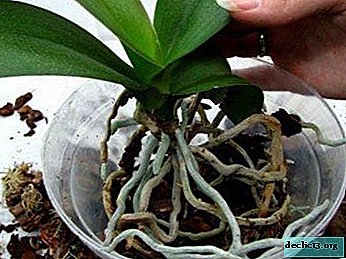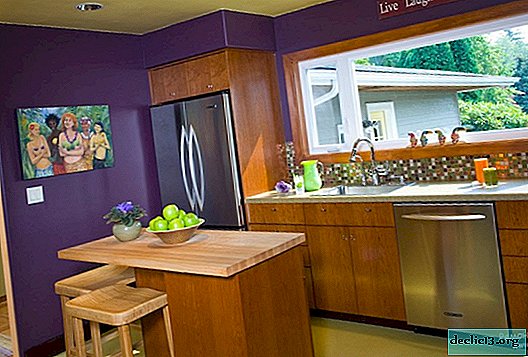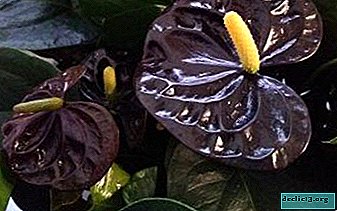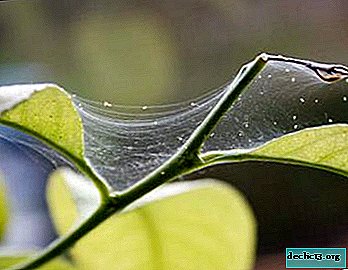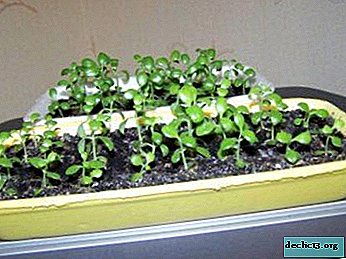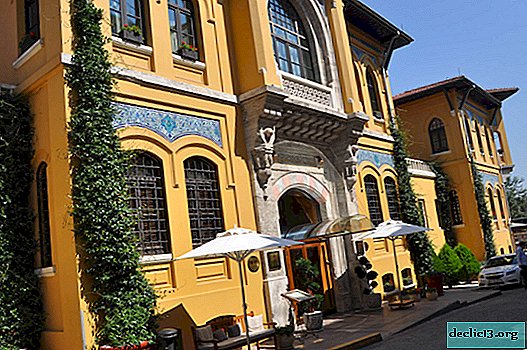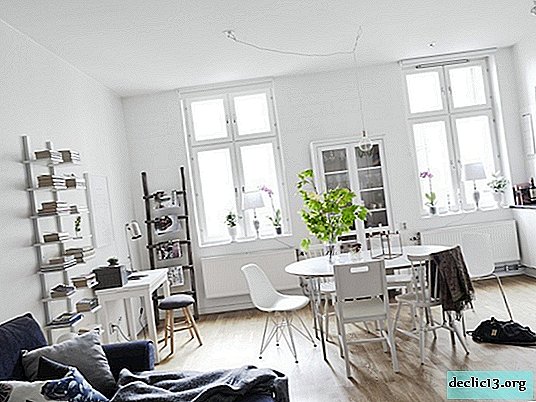A variety of "living stones" and care for these exotic plants
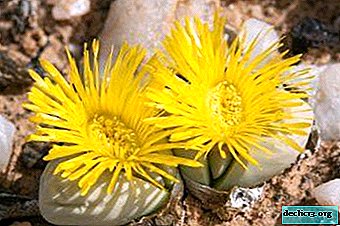 What is this - "Living stones"? These are unique, exotic plants that cause wild delight with their unusual appearance. Popularly, some succulents are called "living stones" or "stone flowers."
What is this - "Living stones"? These are unique, exotic plants that cause wild delight with their unusual appearance. Popularly, some succulents are called "living stones" or "stone flowers."
They got their name for their unusual appearance, which resembles real pebbles. These are plants that can be attributed to indoor plants and grown at home. This will be discussed today in our article.
Botanical characteristics, homeland and prevalence
"Living stones" belong to the genus of succulent plants of the aiza family. Their homeland is Africa, or rather, the arid, southern parts of it. It rains there, sometimes only twice a year, and the conditions for plant growth are extremely harsh. The first plant was discovered and described only in the 19th century, and its research continued only in the 50s of the 20th century.
Attention: Until now, scientists are discovering new species of this succulent. In the natural environment it is rarely possible to meet "living stones", they live only in Namibia, South Africa, Angola and Botswana.Appearance, general and distinctive features from other succulents
Plants look like a pair of fused leaves located on a low thick stem. Sometimes the trunk is completely absent, and the leaves themselves are attached to the root. The surface of the plates is transparent or covered with spots through which sunlight penetrates. Between them there is a small connector (slot), from where other leaves and peduncles grow. Externally, these succulents resemble an oval stone about 5 cm high.
It is interesting that the plant is able to imitate the color of the stones next to which it is located, copy their drawings. This is an excellent disguise from birds and animals, for which the "living stones" are not only food, but also a storehouse of valuable moisture.
Growing “stones” is not at all difficult, but their annual cycles must be strictly observed. Over the year, the plant completely renews its terrestrial part and even grows. He has a dormant period during the hot months with a lack of moisture, and development begins in the fall and continues until spring.
“Living stones” with good care are able to live 15 years or more in room conditions, they can be considered long-livers.
We recommend watching a video about the features of Living Stones succulents:
Plant species of this group and photo
The “living stones" include a number of different plants that are similar in nature.
Argyroderma

A stone-like plant lives on sandy or rocky soils. It consists of 2 or 4 fused semicircular leaves, in diameter not exceeding 3 cm. Peduncles appear from the center of the cleft, from which new leaves also grow, while the old ones die off.
Argyroderma (Argyroderma) is similar to a daisy and is white, white-pink and yellow. About 50 varieties are among this type of succulents.
Aloinopsis

Aloinopsis translates as “aloe-like” because of its appearancebut some varieties are similar to "living stones". Leaves grow up to 4 cm in length, often with blunt tips, smooth or covered with growths. Flowers appear from the center of the outlet, they open in the late afternoon and close again when it gets dark. Shades are pink or yellow, often with a darker strip in the center of each petal.
Aloinopsis Shunes (Aloinopsis Schooneesii) - the closest in appearance to the "stones". He does not form rosettes, and his flowers are orange-yellow. About 15 varieties of the plant are counted.
Bilia

Succulent with thick, fleshy leaves of light green color, named after the wife of a famous plant collector. Biliya flowers consist of five yellow or white petals. They appear in groups of 1 to 3 in late summer - early fall.
It is a fairly frost-resistant plant; however, it is rarely found in open ground. It is unique in its kind - Bijlia Cana.
Gibbeum

Ground cover succulent, reaching a height of 5 cm and forming thickets of 15-20 cm. Active growth occurs in the winter and spring months, and the rest of the time it is at rest. Flowers come in a variety of colors, from purple to red or white and appear in winter, until spring. Leaves grow in pairs and look like pebbles.
The genus Gibbeum has about 20 plant species.
Glottifilum

Currently, 19 plant species are included in the genus Glottifilum. Short or elongated leaf plates are located crosswise, or in two rows. They collect and store moisture. Their color is bright or dark green, but sometimes there are reddish and blue shades. The shape of the leaves varies from round to cylindrical. The color of the flowers is bright yellow, orange, golden, and sometimes white.
Important: Glottifilum blooms twice a year - in mid-summer and early fall.Dinterantus

This is a small genus with only 4 species and 2 species, for example, Dinteranthus vanzylii. Young plants are found individually, but eventually form groups. The color of the leaves, depending on the species, varies from greenish gray to almost white. Some on the surface have specks in the form of a marble pattern. Flowers on a low pedicel are quite large (sometimes reaching 7 cm in diameter) most often light or dark yellow, less often white.
Dinteranthus VANZYLII - has an attractive appearance, the small leaves of which are decorated with marble patterns.
Konofitum

Conophytum grows not in height but in breadth, forming entire colonies. Its growth does not exceed 2-3 cm, and fleshy leaves are usually green, gray or bluish. In autumn, between the leaves, large buds of yellow, pink, white or purple bloom, similar to chamomile buds.
In nature, there are about 280 species of plants, but cultivated many times less.
Lapidaria Margaret

Unlike Lithops, it has from 2 to 4 pairs of leaves 2 cm long and 1 cm wide. The leaves are rather unusual in shape - convex below and flat cream in color above. It blooms in winter, forming yellow buds from 2 to 5 cm in diameter. The genus contains only 1 species - Lapidaria margaretae.
Lithops

It has about 40 varieties. Outwardly, it looks like a pair of fused leaves in the form of an inverted cone, very round. Leaves are painted in gray-blue, green or brown tones. It blooms in autumn, forming small yellow buds.
We recommend watching a video about the features of lithops:
Playospilos

People call it “living granite” for the points on the surface of the sheet plate. Some taxonomists distinguish 4 species and 4 subspecies of a plant, while others number about 20 species.
In appearance, Playospylos is similar to Lithops, the length of the leaves can reach 5-7 cm. On a low pedicel is a daisy-like bud, most often yellow. The plant blooms from August to October.
Titanopsis

Consists of a neat rosette of gray-green leaves, thick at the base and flat at the edge. The leaves are covered with growths and are more like a mineral. Titanopsis flowers are similar to bright yellow daisies the size of a large cherry, bloom for several days and open only in the bright sun.
This genus has from 4 to 8 species that are not very different from each other.
Fritia

This is a small plant with rosettes of leaves of a cylindrical or bottle shape, with truncated tips. The surface of gray-green rough leaves is covered with spots-windows for light. The flowers are single, purple-pink with a white neck, a diameter of about 2.5 cm. At night, the flowers close. The genus Fritia includes only 2 species.
Fenestaria

The genus includes only 1 species, is very similar to Fritia, but differs in a yellow or white shade of flowers. On green leaves, thin at the base and widened at the ends, there is a window for photosynthesis. Fenestaria flowers grow on tall pedicels.
Zerochlamis

It grows in height up to 15 centimeters. The leaves are triangular, fleshy, grow up to 6-5 cm in length. Corrugated leaf texture due to wrinkles covering it, light color, bluish-green. The flowers resemble a daisy or a daisy in shape, they are pink in color with a snow-white base or just white, lilac, lilac.
Home Flower Care
Watering the "living stones" must be correct. In late summer and early autumn, the rainy season begins in Africa. Plants at this time accumulate moisture and need high-quality watering, which gradually disappears and stops by the end of September. Watering is not required at all during flowering. Do not be afraid that the plant will die, because it is well adapted in arid conditions. In spring, watering resumes.
If you pour the "stones", they can rot and die. Among other things, it’s important to remember a few simple rules:
- water for irrigation should be warm and filtered;
- moisture must be avoided on the connector in the leaves;
- the soil between the irrigations should dry completely.
Since the plants are accustomed to an extremely hot climate, a comfortable temperature in summer should be at least +25 degrees. "Living stones" are very affected by cold glasses in winter, it is advisable to put them closer to the edge of the window sill. The minimum allowable temperature is not lower than 10 degrees.
Tip: For “Living stones” low temperature with high humidity is fatal.Lighting is very important for the plant, as in the wild, it is constantly under the open sun. At home, it is necessary to provide at least 4-5 hours of direct sunlight per day. "Stones" will feel great on the windows on the south side of the house. However, in the spring it is better to gradually accustom the plant to light, because a sharp change in lighting can cause burns.
Regarding the composition of the substrate, it is worth noting that the soil should be stony, loose and have neutral acidity. For better drainage, it is necessary to make a thick layer of drainage.
Not all living stones need to be fed, for example, Lithops consume all the necessary substances from the soil. From March to September, Aloinopsis and Playospilos are fed once a month with fertilizers for succulents and cacti, and Zerochlamis loves fertilizers with a high potassium content.
Feeding is selected individually and is carried out in the "active" months, and stops during the rest period.
Reproduction and transplantation
 In the wild, plants reproduce by growing several pairs of leaves or seeds.. In indoor conditions, seed reproduction is more common, because it is very difficult to cut them.
In the wild, plants reproduce by growing several pairs of leaves or seeds.. In indoor conditions, seed reproduction is more common, because it is very difficult to cut them.
Seeds are carefully collected after flowering and begin to germinate in the spring. When the seedlings grow a little, the soil surface can be sprinkled with small pebbles for additional support, and after a year to plant seedlings.
Transplanting "Living stones" is recommended no more than once every 3-4 years. They grow slowly and do not need constant updating of the pot and soil. When choosing a container, remember the long central root of the plant. Deep dishes will provide a comfortable growth of the root system.
Some gardeners claim that "Living Stones" grow better surrounded by their own kind and recommend planting several plants, possibly even different species, in one container.
We described in detail here how to propagate "living stones" at home with seeds and cuttings, as well as about the subsequent care of plants.
Diseases and Pests
Among insects, the mealybug feeding on its leaves is the enemy of succulents.. If a few pests can be collected by hand, and the plant washed with water, but when the colony invades, it is worth using special insecticidal preparations (for example: Aktara, Spark, etc.).
The most common ailments of “stones” include various rot and even mold. In this case, it is necessary to reduce watering and treat the plant with fungicides to prevent the appearance of fungi.
Content difficulties
The difficulties encountered in the cultivation of "Living stones" include:
- Leaves swell and crack - the cause is excessive watering.
- Old leaves have not dried out, and new ones are actively developing - the irrigation system is broken.
- The plant does not bloom - it may be at a young age, insufficient lighting or watering.
Conclusion
"Living stones" in spite of their unpretentiousness, need special care. Only attentive and sensitive flower growers can arouse flowering and extend the life of these plants. They will be an excellent gem of a collection of indoor plants and emphasize the interior.




